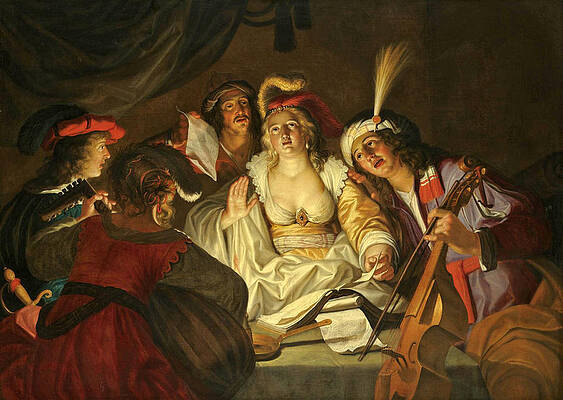Gerard Seghers
The Denial of St. Peter
Christ and the Penitent Sinners
A musical company
The Annunciation
The Virgin in Prayer at the Foot of the Cross, with crying Angels
Judith with the Head of Holofernes
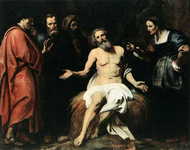
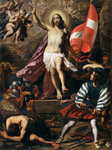

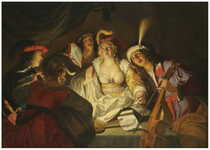


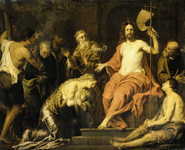
Christ And The Penitent Sinners
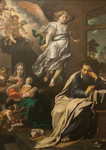
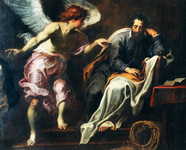
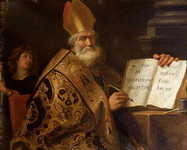
The Four Doctors of the Western Church, Saint Ambrose
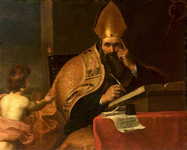
The Four Doctors of the Western Church, Saint Augustine of Hippo (354–430)
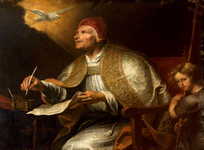
The Four Doctors of the Western Church, Saint Gregory the Great

The Four Doctors of the Western Church, Saint Jerome

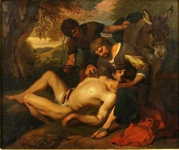
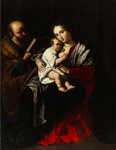
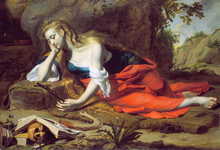
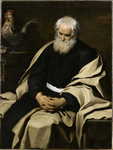

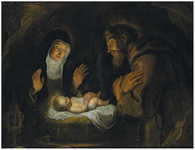
St. Clare and St. Francis of Assisi in adoration before the Child Jesus

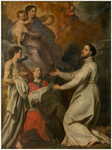
St Norbert Receives the Garment of his Order
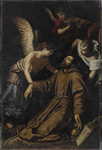
St Anthony comforted by angels after his stigmatisation
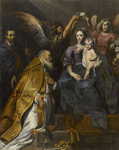
Saint Eligius at the feet of the Virgin and Child
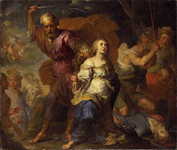
Martyrdom of St Dymphna and St Gerebernus
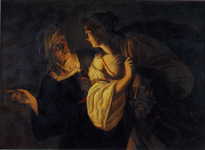
Judith with the Head of Holofernes
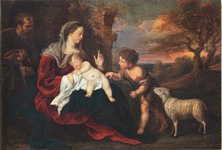
Holy Family with St John the Baptist

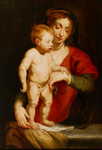
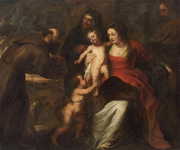
Holy Family, adored by the St Francis
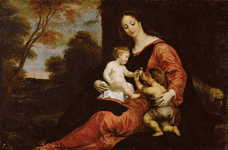
Madonna and Child with Saint John the Baptist

Gerard Seghers (alternative spellings of last name: 'Zegers' and 'Zeghers', first name also 'Geerard' and 'Gerardo')[1][2] (Antwerp, 1591 – Antwerp, 18 March 1651) was a Flemish painter, art collector and art dealer. As a painter of history and genre paintings, he was in his youth one of the leading representatives of the Flemish Caravaggisti movement.[3]
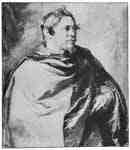
Portrait of the painter Gerard Seghers, Anthony van Dyck
Life
Gerard Seghers was born in Antwerp as the son of innkeeper Jan Seghers and his wife Ida de Neve.[2] He was likely not related to the Jesuit still life painter Daniel Seghers. At the age of 12 he was enrolled as a pupil. It is not clear who his teacher was. Possibly he trained under Abraham Janssens, Hendrick van Balen or Caspar de Crayer (the father of the more famous Gaspar de Crayer).[4]
Saint Sebastian comforted by an angel
In 1608, only aged 17, he became a master in the Antwerp Guild of St. Luke. In 1611 Seghers joined the Society of the Aged Bachelors (Sodaliteit der Bejaarde Jongmans), a fraternity for bachelors established by the Jesuit order.[3]
He left for a trip to Italy before 15 February 1613. It is assumed that he worked there for the Antwerp art merchant Goetkint. At the same time Seghers used the experience for furthering his training as a painter and making copies after famous Italian paintings.
Gerard Seghers visited Naples and Rome as well as other places. In Rome he encountered the followers of Caravaggio, who had himself died a few years before Seghers' arrival in Rome. One in particular, Bartolomeo Manfredi, had as significant impact on his early work.[3] Manfredi was one of the closest followers of Caravaggio and was at the height of his fame when Seghers arrived in Rome. Seghers fell strongly under the spell of Manfredi's work.[5] He likely also met up with the Dutch and Flemish Caravaggisti residing in Rome such as Gerard van Honthorst, Dirck van Baburen and Jan Janssens and possibly also Hendrik ter Brugghen and Theodoor Rombouts.[3]
After Italy, Seghers visited Spain where according to his own report he was in the service of Philip III of Spain.[3] However, the lack of mention of the artist in contemporary Spanish sources, casts doubt on this supposed sojourn in Spain.[6] He was back in Antwerp in the fall of 1620 and the following year he assisted Rubens in the decoration of the Saint Carolus Borromeus church of Antwerp.[7] In 1621 Seghers married Catharina Wouters (d.1656) who came from a respected family. The couple would have eleven children of whom one, Jan-Baptist Seghers (1624-1670), also became a painter.[1] It is assumed that in the period 1624 to 1627 he visited or resided in Utrecht where he would have met the leading Carravagist Gerard van Honthorst whom he likely knew from Rome.[3]
Saint Eligius at the feet of the Virgin and Child
In Antwerp Seghers was successful as a painter and art dealer and was able to afford a house on the fashionable Meir. He was patronized by many monastic orders, including the Jesuits, who commissioned altarpieces from him. He was employed by the city authorities of both Antwerp and Ghent as one of the many artists working on the festive decorations for the Joyous Entry of Cardinal-Infante Ferdinand, the new governor of the Southern Netherlands, in 1635. Seghers' contribution to the Ghent decorations was based on a design by Rubens and was later engraved by Jacob Neefs with the title Belgica implores Charles V to let Ferdinand rule the country and published in a publication on the Joyous Entry into Ghent.[8] Seghers was appointed court painter to the Cardinal-Infante on 25 June 1637. It is possible that in the 1640s he spent some time in Amsterdam.[1] Seghers' work found an eager market abroad, in particular in Spain, thanks to the strong political links between Spain and Flanders as well as Seghers' personal connections with important Spanish personalities such as cardinal Antonio Zapata y Cisneros whom Seghers had become acquainted with during his stay in Rome.[6]
Seghers served as the dean of the Antwerp Guild of St. Luke in 1645.[3] Seghers was a member of the chamber of rhetoric called Violieren since his return to Antwerp in 1620.[2] He further joined the Guild of Romanists. The Guild of Romanists was a society of notables and artists which was active in Antwerp from the 16th to 18th century. It was a condition of membership that the member had visited Rome. In the year 1637 the Guild of Romanists chose Seghers as its dean. By the time he died in Antwerp in 1651, Seghers was a wealthy man who owned a comfortable house and an extensive art collection.[7]
He had many pupils including his son Jan Baptist Seghers, Peter Franchoys, Frans Lucas Peters (I), Pieter Verbeeck (II) and Thomas Willeboirts Bosschaert.[1]
Work
Seghers is known mainly for his monumental genre paintings and large religious and allegorical works. He completed many altarpieces for churches in the Southern Netherlands. Most of his works are executed in a characteristic landscape (horizontal) format.[3]
The denial of Saint Peter (1620-1625)
Stylistically and thematically, Seghers was initially strongly influenced by Caravaggio and in particular the work of Bartolomeo Manfredi, a follower of Caravaggio. Caravaggism, both in history and monumental genre paintings, continued to mark Seghers's work after his return to Antwerp. In contrast to Caravaggio, Seghers preferred a more idealised treatment of his subjects. The influence of the Caravaggisti is seen in his reliance on chiaroscuro, close-ups and an exaggerated expression for dramatic effect. He often used figures as repoussoirs to obscure the light source (often candlelight). A work from this early period is his Judith with the Head of Holofernes in the Galleria Nazionale d'Arte Antica, Rome as well as the The Denial of Saint Peter in the North Carolina Museum of Art.[3][9] Favourite themes were scenes of music making and card playing.[2]
The theme of the Denial of Saint Peter seems to have been particularly dear to him as at least 10 versions by his hand are known.[10] The theme lent itself easily to genre treatment. Seghers was mainly interested in depicting people of flesh and blood, preferably in a moment of crisis which allowed the artist to paint their various facial expressions. The masked candle he used heightened the expressiveness and added a spiritual dimension. Many copies of his versions of this theme were produced by himself and his studio. The Flemish painter Michael Angelo Immenraet repeated one of Seghers' variation on the theme in his programme of decorative paintings on biblical themes he painted for the Unionskirche, Idstein in Germany.[11]
After 1630, his palette lightened up considerably and the dark background was replaced by architectural motifs, clouds and landscape elements. The realistic facial expressions became more Classicist and he used more variations of colour. These changes reflected the influence of Peter Paul Rubens with whom Seghers closely collaborated during the 1630s.[3] This influence went even so far that in his painting the Adoration of the Magi (1630, Church of Our Lady, Bruges) he adopted Rubens' composition for his treatment of the same subject.[9] It is with this style that he achieved his greatest success in his career. His most important and most characteristic works were painted between 1630 and 1640. Afterwards, he changed to a more gracious and elegant, but also less monumental style. His colours became weaker and the draperies more linear.[12]
While Seghers typically worked on a large scale, he also produced various works on a small scale and on copper for the export market or private use. These smaller works were often reduced copies or variations of his own works.[6][13] Many of Seghers' compositions were engraved by the Antwerp engravers such as Jacob Neefs, Paulus Pontius and Schelte a Bolswert. These prints have assisted in attributing a number of paintings that were deemed lost to Gerard Seghers.[14]
Notes
Christ and the penitents
Gerard Seghers at the Netherlands Institute for Art History (Dutch)
Frans Jozef Peter Van den Branden, Geschiedenis der Antwerpsche schilderschool, Antwerpen, 1883, p. 879-884 (Dutch)
Matthias Depoorter, Gerard Seghers at Barok in Vlaanderen
Ford-Wille, Clare. "Seghers, Gerard." The Oxford Companion to Western Art. Ed. Hugh Brigstocke. Oxford Art Online. Oxford University Press. Web. 18 Jul. 2014
Gerard Seghers, A musical company at Sotheby's
Jahel Sanzsalazar, Gérard Seghers, pintor en grande y en pequeño. Nuevas pinturas identificadas, Localización: Archivo español de arte, ISSN 0004-0428, Tomo 80, Nº 319, 2007, p,. 323-332 (Spanish)
Biography of Gerard Seghers at the National Gallery of Art
A copy of the print at the Rijksmuseum
Seghers, Gerard at Prado Enciclopedia online (Spanish)
Nicolson, Benedict (June 1971). "Gerard Seghers and the 'Denial of St Peter'". The Burlington Magazine 113 (819): 302, 304–309. Retrieved 28 October 2013.
Benedict Nicolson, Gerard Seghers and the 'Denial of St Peter, The Burlington Magazine, Vol. 113, No. 819 (Jun., 1971), pp. 302+304-309
Carl Van de Velde. "Seghers, Gerard." Grove Art Online. Oxford Art Online. Oxford University Press. Web. 18 Jul. 2014
Gerard Seghers, The Annunciation at Sotheby's
Jahel Sanzsalazar, Gérard Seghers y el Marqués de Leganés : nuevas pinturas identificadas, in: Goya. Revista de Arte (2009) 329, p. 283-293 (Spanish)
----
Fine Art Prints | Greeting Cards | Phone Cases | Lifestyle | Face Masks | Men's , Women' Apparel | Home Decor | jigsaw puzzles | Notebooks | Tapestries | ...
----
Artist
A - B - C - D - E - F - G - H - I - J - K - L - M -
N - O - P - Q - R - S - T - U - V - W - X - Y - Z
Retrieved from "http://en.wikipedia.org/"
All text is available under the terms of the GNU Free Documentation License





